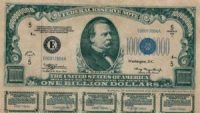The counterfeit bond, which led the FBI to a second arrest, had been printed on an inkjet printer.
The counterfeit bond was supposedly issued in 1934, reported Sun Sentinel, and contained a security thread which was not invented in that decade. Having been declared genuine by Michael Ifrah, who was sent the photo of the bond by friend Barrios Brecino, the pair set about trying to cash it in. Ifrah, who is an international consultant to small businesses and has joint US and Venezuelan citizenship, was arrested after being questioned by the Secret Service when he and Brecino met with a financial advisor, who was in fact an undercover agent who had been tipped off by the real advisor.
Ifrah and Brecino asked for $500 million (€459 million), which they wanted to be deposited in “an investment account”, and a further $500 million to be deposited in a bank account, both in Brecino’s name. Ifrah pleaded not guilty, but the judge detained him, as if he left the country the US would not be able to extradite him, and then agents discovered that he was more involved than initially thought.
Had the two men searched on Google they would have found enough information to realise that the scam was not going to work, as inkjet printing and security threads were technologies that had not been invented in 1934. They had also made the fake to appear that it was issued by the Federal Reserve and not the Treasury, as well as featuring “a portrait of Grover Cleveland”, who was President during the 1800s. Both men are facing federal charges, and Brecino is expected to plead guilty.
The bond had been “manipulated” from a “genuine $1,000 (€918) note”, and prosecutors said that the “largest bond ever issued” was a $1 million (€91,000) bond in 1970. Prosecutor Daniel Cervantes recorded that “this case is about two defendants trying to cash an unbelievable amount of money- $1 billion (€918 million). Few people have actually seen a billion-dollar bond ,and that is because these bonds do not legally exist.”
